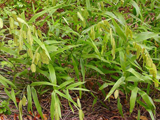Native Plants

Q. Who is Mr. Smarty Plants?
A: There are those who suspect Wildflower Center volunteers are the culpable and capable culprits. Yet, others think staff members play some, albeit small, role. You can torture us with your plant questions, but we will never reveal the Green Guru's secret identity.
Did you know you can access the Native Plant Information Network with your web-enabled smartphone?
Ask Mr. Smarty Plants is a free service provided by the staff and volunteers at the Lady Bird Johnson Wildflower Center.

rate this answer
Wednesday - November 09, 2011
From: Georgetown, TX
Region: Southwest
Topic: Deer Resistant, Privacy Screening, Grasses or Grass-like
Title: Additional screening under yaupons in Georgetown TX
Answered by: Barbara Medford
QUESTION:
We live on a corner and have a berm along the south side of our yard which blocks our backyard from the street. It was planted with uprights yaupons. With the drought, deer have eaten the bottom portion of the yaupons, and our backyard is no longer screened. What would you suggest we plant under the yaupons to fill in the gaps?ANSWER:
The deer have really been a factor in all kinds of plantings during this drought year. They have to eat, too, and will eventually get around to just about anything they can reach, including some plants on our Deer-Resistant Species list. Although there are a number of plants that would fill in that space beneath the nibbled yaupons, there's really not much use putting resources into something that is promptly going to be munched. Also, there is the issue of shade from the yaupons or perhaps other vegetation or walls.
We are going to our Deer-Resistant Species list, select on Texas and "grasses/grasslike" under Habit. We also selected on Height, 3 to 6 ft. Each one on this is list is considered highly deer resistant. Deer don't graze grass much, anyway, and several of these have sharp-edged leaves. Follow each plant link to find out what kind of sun exposure each needs, whether they are evergreen and how to propagate. Another good thing about grasses is that they have long fibrous roots that will help stabilize your berm.
Aristida purpurea (Purple threeawn)
Bouteloua curtipendula (Sideoats grama)
Muhlenbergia capillaris (Gulf muhly)
Nassella tenuissima (Mexican feathergrass)
Andropogon gerardii (Big bluestem)
Chasmanthium latifolium (Inland sea oats)
From the Image Gallery
More Privacy Screening Questions
Evergreen Privacy Screen for Maryland
November 19, 2012 - I am looking for an evergreen that will suffice to be planted as a privacy screen between my property and my neighbors. Looking to plant a row at the property line.
The lot is shaded most of the d...
view the full question and answer
Evergreen pet-safe shrubs for house and screening in McKinney TX
April 15, 2010 - Looking for shrub, preferably evergreen, to plant near the house that can handle wet ground and is pet (dog, cat, horse) safe. The area became boggy after we had an underground water leak that is now ...
view the full question and answer
Shrub to screen backyard and block noise
March 14, 2009 - I'm trying to find a shrub to screen my backyard and block noise. I want something I can plant along the 60ft of my back fence that would get between 8 and 10 ft tall. I would like something that att...
view the full question and answer
Evergreen hedge for NY
February 26, 2012 - I am looking for a native evergreen shrub that could be used as a hedge or privacy screen on the Rockaway peninsula in Queens county. It is a beach community with sand soil ( except where it has been...
view the full question and answer
Privacy hedge for East Texas
January 07, 2009 - I need suggestions for a native shrub/bush as a privacy hedge for East Texas conditions. Thank you.
view the full question and answer
| Support the Wildflower Center by Donating Online or Becoming a Member today. |

